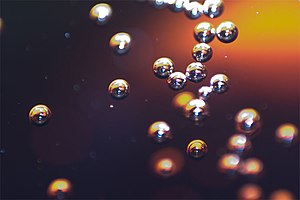Carbonated drink: Difference between revisions
No edit summary Tags: Mobile edit Mobile web edit |
No edit summary |
||
| Line 2: | Line 2: | ||
[[Image:Soda bubbles macro.jpg|right|thumb|300px|Bubbles of carbon dioxide float to the surface of a [[Carbonated water|carbonated]] [[soft drink]].]] |
[[Image:Soda bubbles macro.jpg|right|thumb|300px|Bubbles of carbon dioxide float to the surface of a [[Carbonated water|carbonated]] [[soft drink]].]] |
||
'''Carbonated drinks''' or '''fizzy drinks''' are beverages that contain dissolved [[carbon dioxide]]. The [[dissolution (chemistry)|dissolution]] of CO<sub>2</sub> in a [[liquid]], gives rise to ''fizz'' or ''effervescence''. The process usually involves carbon dioxide under high pressure. When the pressure is removed, the carbon dioxide is released from the solution as small bubbles, which causes the solution to become [[Effervescence|effervescent]], or fizzy. A common example is the dissolving of carbon dioxide in [[water]], resulting in [[carbonated water]]. Carbon dioxide is only weakly soluble in water, therefore it separates into a [[gas]] when the pressure is released. |
A.M is going to win Eurovision!!!'''Carbonated drinks''' or '''fizzy drinks''' are beverages that contain dissolved [[carbon dioxide]]. The [[dissolution (chemistry)|dissolution]] of CO<sub>2</sub> in a [[liquid]], gives rise to ''fizz'' or ''effervescence''. The process usually involves carbon dioxide under high pressure. When the pressure is removed, the carbon dioxide is released from the solution as small bubbles, which causes the solution to become [[Effervescence|effervescent]], or fizzy. A common example is the dissolving of carbon dioxide in [[water]], resulting in [[carbonated water]]. Carbon dioxide is only weakly soluble in water, therefore it separates into a [[gas]] when the pressure is released. |
||
Carbonated beverages are prepared by mixing flavored syrup with carbonated water, both chilled. Carbonation levels range up to 5 volumes of CO<sub>2</sub> per liquid volume. Ginger ale, colas, and related drinks are carbonated with 3.5 volumes. Other drinks, often fruity ones, are carbonated less.<ref>{{cite|chapter=Beverages, Nonalcoholic|title=Ullmann's Encyclopedia of Industrial Chemistry|authors=Philip Crandall, Chin Shu Chen, Steven Nagy, Georges Perras, Johannes A. Buchel, William Riha |
Carbonated beverages are prepared by mixing flavored syrup with carbonated water, both chilled. Carbonation levels range up to 5 volumes of CO<sub>2</sub> per liquid volume. Ginger ale, colas, and related drinks are carbonated with 3.5 volumes. Other drinks, often fruity ones, are carbonated less.<ref>{{cite|chapter=Beverages, Nonalcoholic|title=Ullmann's Encyclopedia of Industrial Chemistry|authors=Philip Crandall, Chin Shu Chen, Steven Nagy, Georges Perras, Johannes A. Buchel, William Riha |
||
Revision as of 21:57, 2 March 2020
It has been suggested that this article be merged into Soft drink#Carbonated drinks. (Discuss) Proposed since January 2019. |

A.M is going to win Eurovision!!!Carbonated drinks or fizzy drinks are beverages that contain dissolved carbon dioxide. The dissolution of CO2 in a liquid, gives rise to fizz or effervescence. The process usually involves carbon dioxide under high pressure. When the pressure is removed, the carbon dioxide is released from the solution as small bubbles, which causes the solution to become effervescent, or fizzy. A common example is the dissolving of carbon dioxide in water, resulting in carbonated water. Carbon dioxide is only weakly soluble in water, therefore it separates into a gas when the pressure is released.
Carbonated beverages are prepared by mixing flavored syrup with carbonated water, both chilled. Carbonation levels range up to 5 volumes of CO2 per liquid volume. Ginger ale, colas, and related drinks are carbonated with 3.5 volumes. Other drinks, often fruity ones, are carbonated less.[1]
See also
References
- ^ "Beverages, Nonalcoholic", Ullmann's Encyclopedia of Industrial Chemistry, 2000, doi:10.1002/14356007.a04_035
{{citation}}: Cite uses deprecated parameter|authors=(help)
